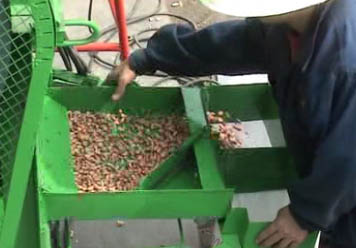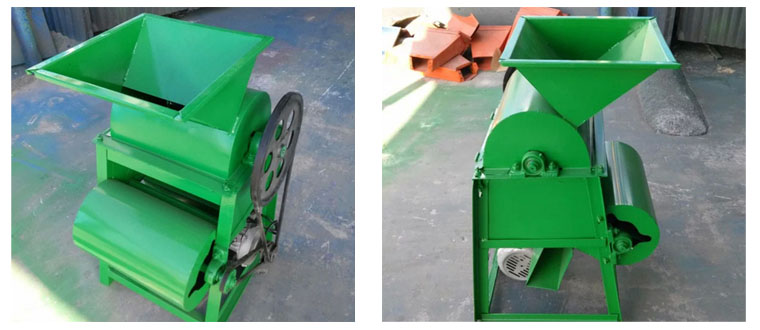- Newest Hot Sale High Quality peanut shelling machine for Sale
In recent years, with the expansion of planting area of peanut, the number of users purchasing peanut shelling machine is increasing. Compared with manual shelling, the mechanical shelling machine can largely reduce labor work of farmers, which saves a lot of manpower and greatly improves the work efficiency.
But a lot of users have not really grasped the correct use of peanut shelling machine and maintenance methods in production so that the performance of peanut shelling machine can not be fully played; on the other hand, inappropriate preservation methods lead to serious wear of peanut shelling machine, which not only cause poor quality of peanut shelling and low efficiency, but bring unnecessary economic losses for farmers. In order to make full use of peanut shelling machine, now we are going to introduce the use and maintenance technology of peanut shelling machine in detail.
The main structure of peanut shelling machine is composed of two parts: the stoning machine and shelling machine.
Stones in the peanuts should be removed first by specific gravity stoner. Then, stones and other heavy debris would be sent upward and sifted out from the machine through the gravity separating sieve; while peanuts would be sent downward along the stoner and gravity sieve. After passing through the gravity stoner, peanuts would move downward along gravity sieve and sent automatically to the feeding hopper of peanut shelling machine, then fall in the first drum by the primary fan. Then, the peanuts would move upward. In the collision between the concave plate of grid and the rotor, peanut shells and kernels are separated and fall through the former sieve at the same time. When moving through the air duct, the wind from the air blower would blow the majority of light peanut shells out of the machine. While peanuts and a part of unshelled peanut fruits would fall into the gravity separation sieve together. After screening, peanut kernels would be sent upward and flow into the sacks through the discharging outlet. While unshelled peanut fruits are sent downward from the sieve surface and flow into the secondary fan. Then, they would be sent into the drum by air blower for the second shelling with fine grid concave plate. After screening by the gravity separation sieve, peanut kernels are sent upward and peanut shells are blown out of the machine to achieve the final purpose of shelling.
 3. The use of peanut shelling machine
3. The use of peanut shelling machine1). Moisture preparation before shelling
Peanuts should have proper moisture content before shelling, that is, they can not be too dry or too wet. If the peanuts are too dry, the broken rate would be higher; while too wet would affect the working efficiency. Generally, the moisture content of peanut is about 9%. Peanuts are often shelled in winter in northern areas. However, the peanuts stored in rural areas are relatively dry. In order to make the peanuts in proper moisture content, the following methods can be used: spray about 5 kilograms of warm water evenly on 100kg of peanuts and covering with a plastic film for 10 hours or so, and then drying in the sun for about one hour and the peanuts can be shelled.
In other seasons, the covering time should be 6 hours or so and the rest processes are the same.
2). Preparation of machine before shelling
Before shelling, the operator should check whether the machine has been placed steadily first to achieve the purpose of safe operation. Then, he should also check whether the fastener is tightened, the rotating part is flexible and each bearing has lubricating oil or not to ensure that the tightness of the fastener is appropriate and the rotation part is flexible. If there is insufficient amount of lubricating oil in each bearing, the operator should add lubricating oil with a oil gun timely to ensure lubrication between the bearings.
Before use, connect the 380 volt three-phase power supply and check the power supply voltage. Make sure the switch is OFF before turning on power.
In order to ensure the safety of the operator, if the three-phase power supply is not used in the production, then ground protection should be taken for the outer casing of the motor, that is, connect the outer casing of the electric motor with the grounding body reliably by the wire, and if the three-phase power supply is used in the production, the grounding protection can not be adopted.
Idling the peanut shelling machine for several rounds with manual labor before switching on the power to check whether the rotation is smooth. Identify the reason if there is a crash, then switch on the power.
When switching on the power, test run should be made first. The direction of the rotor rotates should be consistent with the direction the machine marks. Idling for a few minutes first to observe whether there is abnormal noise. When the machine is in normal and stable operation, then peanut shelling can be made.

3). The choice of screen mesh
Choose suitable screen according to the peanut size before shelling, which can greatly improve the production efficiency and reduce the breakage rate.
In addition, close the baffle plate and hang up the sack for receiving peanut kernels after shelling.
4). Stoning machine preparations
Before starting the stoning machine, first bespread the sieve bottom with peanut fruits to avoid the peanuts from being blown out from the sieve by wind after starting the machine.
Turn the stoning machine on and operate for 2 minutes, then normal working can be made. The stoning machine in the peanut shelling can be used to remove the debris in peanut fruits on the one hand; on the other hand, it can provide motives for peanuts into the feeding hopper automatically.
Notes: until the stoning machine is in normal operation, leave some peanuts on the sieve bottom to prevent the peanut fruits from being blown out the sieve surface.
5). Notices in use of peanut shelling machine
Peanut feeding should be uniform and in right amount when shelling peanuts. Iron, stones and other debris must not be contained in the peanuts in order to prevent broken peanuts and cause mechanical failure.
In use of peanut shelling machine, the temperature of motor can not be more than 60 degrees Celsius and the temperature of the bearing can not exceed 25 degrees Celsius. When the temperature is too high, the operator should find out the reason timely and remove the fault.
The operator should reduce the amount of peanut feeding if there are too many broken kernels; when in operation, people must not stand on the side of the drive belt so as not to hurt.
Peanut shelling machine adopts triangle belt for transmission. After being used for a period of time, the new belt will be gradually stretched and relaxed due to the tension, so regularly check for the tension of the drive belt and the clearance of connecting parts is quite necessary, then timely adjustment can be made.
In the operation process of peanut shelling machine, the operator should always pay attention to the speed, sound and temperature. After shelling one kind of peanut or working continuously for a whole day, the operator had better stop the machine and check whether the bearing is overheated and the tightening screw and key pin of each part is loose or not. Tighten the part timely then it is loose, especially the part of high speed, such as the wind turbine blade, especially whether the lower wind turbine blade is broken or frayed, the external reinforcement plate of blade is frayed or out of shape. Repair or replace the part in time if the problem is found.
Check the hanging shaft and all the active joints of the screen timely to find out whether there is shortage of oil and wear phenomenon. Replace the part or add oil timely when that occurs. Every time after shelling, clean up the sieve bottom plate of peanut shelling machine, namely apertures of cowl flap with a wire brush regularly.
At the end of the processing season, make a comprehensive check for the peanut shelling machine , including the operation and wear of the bearings, whether there is deformation or crack in the screen bottom and the wear of separating sieve. After the inspection, repair the damaged part and remove the dirt and residual peanuts.
Remove the belt after using and hang on the dry indoor wall and not be exposed to the sun.With rational use and safe operation, the peanut shelling machine will be your good helper in the production!
The content above are matters that need to be noticed in the operation of peanut shelling machine. Correct operation and maintenance of peanut shelling machine can effectively prolong the service life and improve the work efficiency of peanut shelling machine, thus bring more profits for customers.
Some requirements for correct use of peanut shelling machine
Maintenance of Bk-700 peanut sheller
Factory direct small peanut shelling machine
The structure of scraper peanut shelling machine
The function of vibrating screen of peanut shelling machine
Lubrication points of peanut sheller machine
What are the requirements of peanut sheller for materials?
Adjustment in the operation of peanut shelling machine